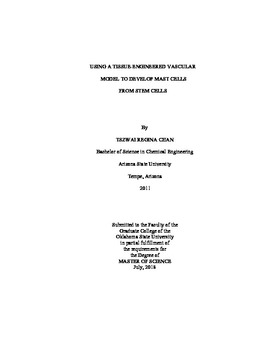| dc.contributor.advisor | Gappa-Fahlenkamp, Heather | |
| dc.contributor.author | Chan, Tszwai Regina | |
| dc.date.accessioned | 2019-07-19T14:08:49Z | |
| dc.date.available | 2019-07-19T14:08:49Z | |
| dc.date.issued | 2018-07-01 | |
| dc.identifier.uri | https://hdl.handle.net/11244/320970 | |
| dc.description.abstract | Over the last few decades, the prevalence of allergic diseases has increased dramatically in developed nations. Mast cells (MCs) play a key role in allergic responses. However, it is difficult to isolate high numbers of viable and mature MCs. Others have determined methods to grow MCs in traditional two-dimensional (2D) cell culture from various adult stem cell sources. Our previous studies have shown that it is possible to develop committed MC precursors in a 3D extracellular matrix-like environment. Our long-term goal is to develop a tissue-engineered vascular model that includes CD133+ hematopoietic stem cells (HSCs) along with fibroblasts within a 3D matrix, to represent the tissue space, and a layer of endothelial cells (ECs) on one surface, to represent the capillary endothelium. The objectives of this project were to identify which source of adult human CD133+ HSCs generated the greatest number of viable and mature MCs within the model and to determine the effect of fibroblasts and ECs to the growth and differentiation of MCs within the model. HSCs from human adult peripheral blood mononuclear cells (PBMC), adult granulocyte colony-stimulating factor-mobilized peripheral blood mononuclear cells (G-PBMC), and cord blood were mixed with fibroblasts within a collagen matrix and incubated with StemSpan media supplemented with cytokines. Samples were incubated for eight weeks, with ECs seeded on the surface of the matrix in the last week. MCs were characterized based on cell morphology, viability, intracellular stores of preformed factors, cell surface marker expression, and the release of soluble mediators. The results show that HSCs isolated from G-PBMC generated the greatest number of viable and mature MCs within the 3D co-culture model. The data demonstrated that 3D co-culture system had a higher yield of mature MCs than the traditional 2D cell culture system without fibroblasts and ECs. | |
| dc.format | application/pdf | |
| dc.language | en_US | |
| dc.rights | Copyright is held by the author who has granted the Oklahoma State University Library the non-exclusive right to share this material in its institutional repository. Contact Digital Library Services at lib-dls@okstate.edu or 405-744-9161 for the permission policy on the use, reproduction or distribution of this material. | |
| dc.title | Using a Tissue-Engineered Vascular Model to Develop Mast Cells from Stem Cells | |
| dc.contributor.committeeMember | Ramsey, Joshua D. | |
| dc.contributor.committeeMember | Meinkoth, James H. | |
| osu.filename | Chan_okstate_0664M_15929.pdf | |
| osu.accesstype | Open Access | |
| dc.description.department | Chemical Engineering | |
| dc.type.genre | Thesis | |
| dc.type.material | Text | |
